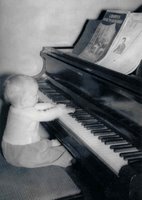 One summer, when Mendelssohn was 17, he was reading Shakespeare's play, A Midsummer Night's Dream.
One summer, when Mendelssohn was 17, he was reading Shakespeare's play, A Midsummer Night's Dream.To explain what the play's about in 25-words-or-less is pretty difficult, but there are two couples who get lost in the woods on a summer night, trying to sort out their relationships. The forest is also the realm of sprites and fairies (see left) where the king (Oberon) is having trouble with his own relationship. Oberon tries to get one of his spirits (Puck, in picture with both arms raised) to help him but he gives him only some vague instructions. An unexpected encounter with the two mortal couples only makes things more complicated. Then you add a bunch of comedians who are trying to rehearse their play - part of the festivities for the Duke's wedding - and it just gets even stranger... But it all works out in the end as Puck manages to correct his mistakes.
It inspired Mendelssohn to turn this story into a piece of music.
 It opens with a kind of "Once upon a time" sound, this series of almost still chords, before it breaks off (at 0:28) into the scurrying, whispered sounds of the sprites. There are some hesitant chords (as if someone's stopping to look around) at 0:56 & 1:10 before the Mortal Couples (see right) burst in at 1:16. The Fairies return at 1:46 and then we hear some tenderer music as the couples try to work things out (well, one of the girls is in love with a boy who doesn't love her) at 2:13. There are a couple of fanfares at 2:44 - echoes of the distant city? reality? the approach of the Royal Wedding? Then suddenly - bang! at 3:09, in come "the rustics," a troupe of "mechanicals" (the rough
It opens with a kind of "Once upon a time" sound, this series of almost still chords, before it breaks off (at 0:28) into the scurrying, whispered sounds of the sprites. There are some hesitant chords (as if someone's stopping to look around) at 0:56 & 1:10 before the Mortal Couples (see right) burst in at 1:16. The Fairies return at 1:46 and then we hear some tenderer music as the couples try to work things out (well, one of the girls is in love with a boy who doesn't love her) at 2:13. There are a couple of fanfares at 2:44 - echoes of the distant city? reality? the approach of the Royal Wedding? Then suddenly - bang! at 3:09, in come "the rustics," a troupe of "mechanicals" (the rough  comedians) who've come to rehearse their play. This is the comic relief of the story - the leader of the comedians is a guy named Bottom who gets transformed into a man with a donkey's head later in the play (see left) with amusing consequences for Oberon's wife (that's the illustration that covers the 'video'). What's that sound at 3:14, 3:17 and again at 3:27? Hee-haws? Hmmm, you think...?
comedians) who've come to rehearse their play. This is the comic relief of the story - the leader of the comedians is a guy named Bottom who gets transformed into a man with a donkey's head later in the play (see left) with amusing consequences for Oberon's wife (that's the illustration that covers the 'video'). What's that sound at 3:14, 3:17 and again at 3:27? Hee-haws? Hmmm, you think...?The fanfares return at 3:32, but this time seem to be more likely associated with the Duke and his impending wedding or perhaps the fairy court of King Oberon... then the fairies are scurrying about again at 3:57 and those hesitant chords mean they're probably on the look-out for... well, trouble, probably.
And so in 4 minutes of music, Mendelssohn introduces you to three sets of characters in Shakespeare's play: the fairies, the two mortal couples and the "rustics," each one turned into musical ideas you can keep separate by the way they differ from each other.
After that, things go off and get mixed up - there's some genuine pleading going on at 5:41 - before we hear everything (in Part 2) almost just like it was at the opening again.
Part 1
- - - - - - -
- - - - - - -
This time (in the 2nd clip, posted below), the fairy music begins at 0:39 (no hesitant looking-around, though), the couples' love-music comes back at 1:17 (but not bursting in) with the distant fanfares at 1:46 before the Rustics come romping back for another appearance at 2:11 (the hee-haws at 2:16); more mortals' music at 3:17 with fanfares at 3:20 with another scurrying by from the fairies at 3:40. It sounds like we're working toward a quiet "happily ever after" ending by 4:36 and then we end with the same chords we heard, once upon a time, at the beginning of the piece (now at 5:24) and that's how it ends. Just like a dream.
Part 2
- - - - - - -
- - - - - - -
Not bad for 17!
- Dr. Dick (who's not seen 17 for many years...)

